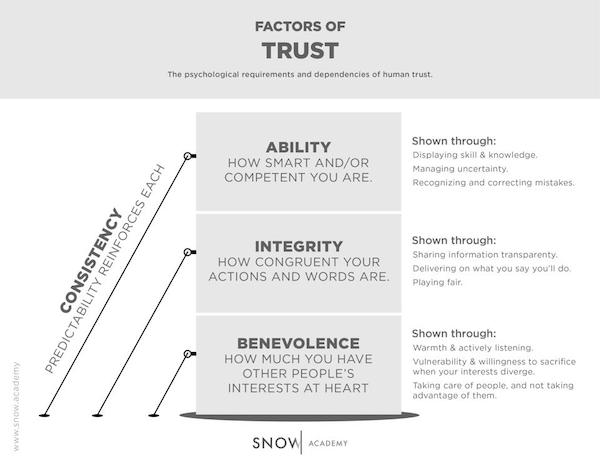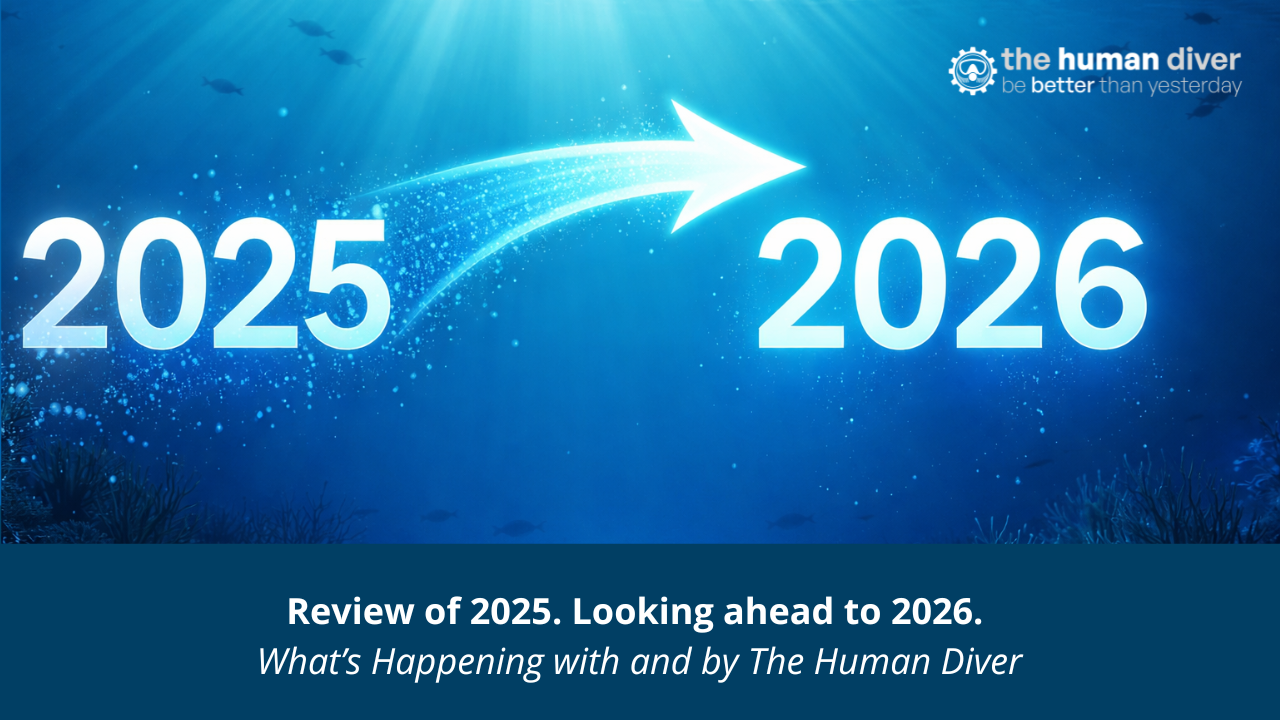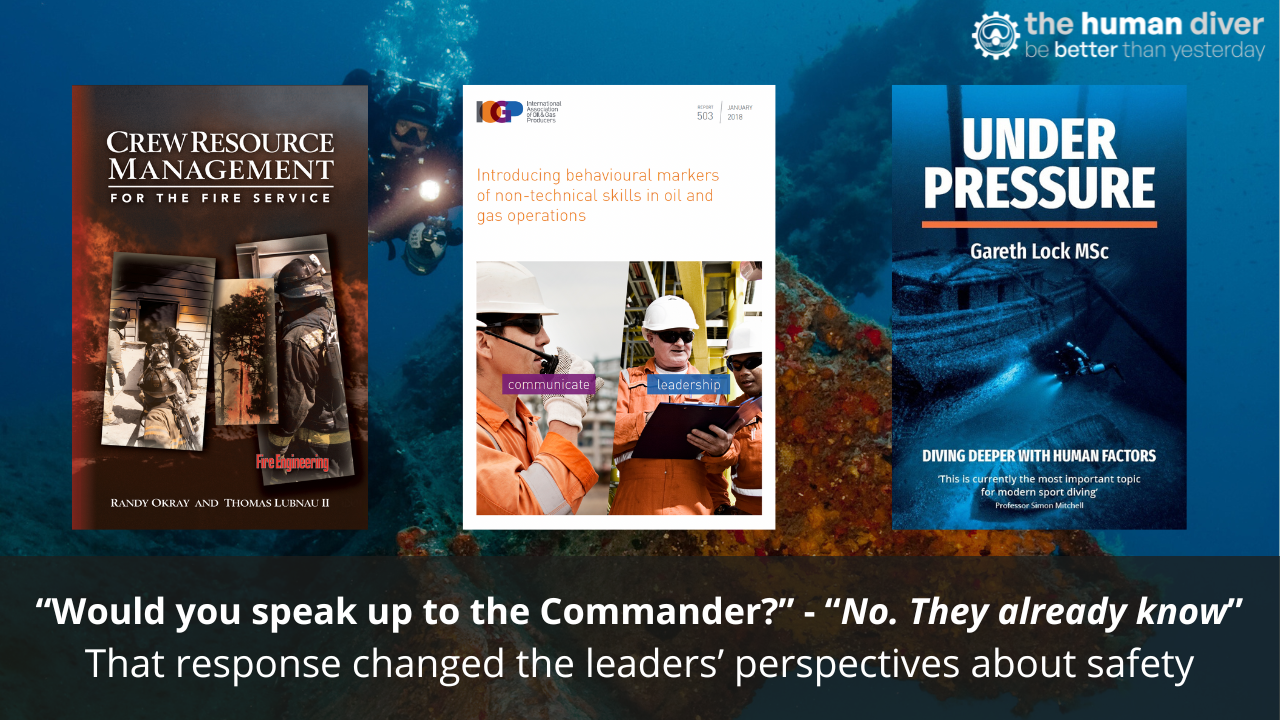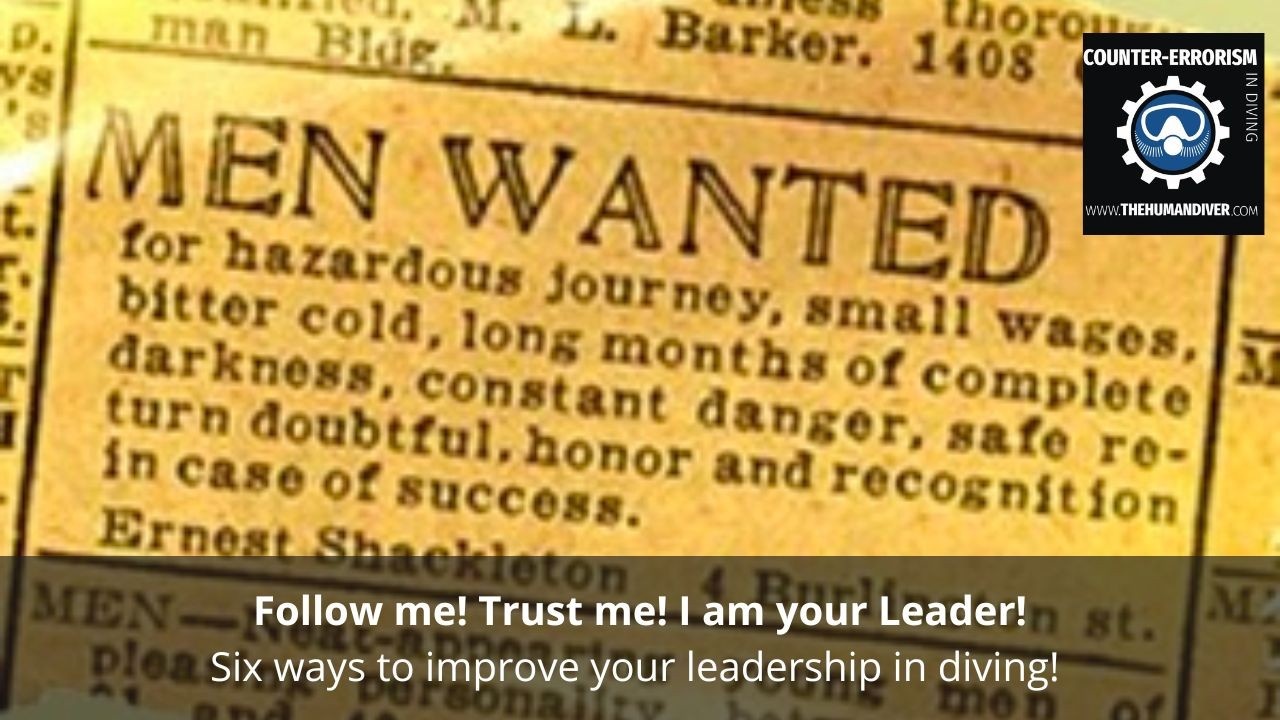
Follow me! Trust me! I am your Leader!
Nov 13, 2022“Men wanted for hazardous journey. Low wages, bitter cold, long hours of complete darkness. Safe return doubtful. Honour and recognition in the event of success. Ernest Shackleton.” What an advert! Unfortunately, the weather got in the way of their goal to get to the South Pole. However, Shackleton met a much greater goal, getting his men back safely despite incredible odds. They all worked together as an effective team, around a common purpose. This was a demonstration of incredible leadership in very uncertain conditions. Fortunately, we don’t have to face these sorts of struggles in diving, but the role of leadership is certainly needed, especially if you are an instructor, running a dive centre or leading a project.
Leadership in diving is a subject not talked about very often, but it is critical to successful outcomes when dealing with uncertain situations. The uncertainty doesn’t just apply to you, as uncertainty will also be present for students on a diving course, instructor candidates on a development programme, divers on your boat or members of a diving project. To help you all, this blog will give you some ideas and tools that you can use in whatever type of diving you do.
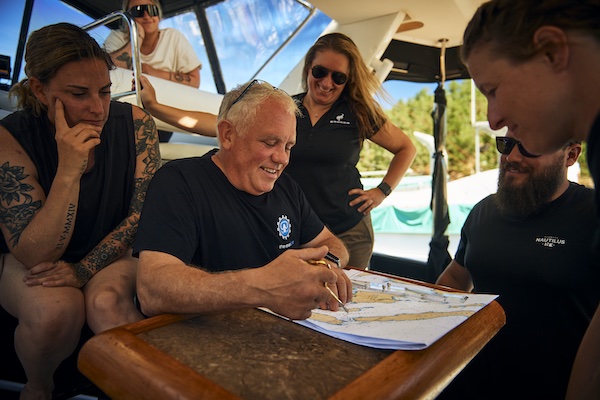
What is Leadership?
First off, what is leadership? Leadership is a huge topic with many books and papers written on the topic. Here are a couple of definitions for you to think about.
- “Leadership is the art of influencing others to do what we want them to do because they want to do it.” – Edington and Ford
- “There is no prescription of leadership and no prescribed style of leader. Leadership is a combination of example, persuasion, and compulsion, dependent on the situation.” – UK Defence Leadership Centre
- “The ability to influence someone to do something, without the use of authority” – Carl Hartford PhD, Leeds University
I recently sat in on a presentation by Dr. Carl Hartford, a colleague of mine, who was working with senior executives in a high-risk business. Carl explained the different ways of influencing people: authority, management, and leadership.
- Authority is based on titles, positions, and roles. It is directive or autocratic in nature and people will follow, in the main, what they are told to do even if they don’t necessarily agree. Trust is based on authority, not necessarily on the person themselves. There is no personal relationship needed because it is very much about controlling the situation.
- Management is based on procedures, processes, and rules. It requires little effort on the part of the leader to make the change happen. “Do this because the rules say so.” or “The standards say we have to do four dives to qualify that student.” Again, there is no real personal relationship at this level of influence. You can’t ‘process’ a team together, it requires leadership.
- Leadership is based on relationships and personal behaviours. The followers in the team will do what is asked of them because they want to do it, rather than because they have to do it. To lead effectively, you must have a level of emotional connection with your team. They must trust you that you have their best interests at heart, that you have integrity and will ‘walk the talk’, that you have some level of competence regarding the activity you are teaching/involved in, and most importantly, you are consistent in your actions. You have to be able to create psychological safety, which is a shared belief within the team that it is okay to learn, to make mistakes, to contribute and to challenge the status quo. Trust is based on 1:1 relationships, psychological safety is 1:many and many:1.
In diving, especially diving instruction, much is made of the first two types of influence (authority and management), but you are not going to get the best out of your students or team if you only apply this strategy. You certainly won’t be creating thinking divers or instructors if the process is the only thing they follow. Instructors should be teaching divers how to dive in the real world, not how to pass a class. The same goes for Instructor Trainers and Course Directors developing instructors. While the standards state the minimum, that doesn't mean they are useful. Goodhart's Law addresses this point.
Six ways to be a more effective leader in diving instruction.
- What is your purpose? Every educational class is a team effort: the instructor is the leader, and the students are the followers. The instructor and students, leaders and followers, revolve around a common purpose. If you go into a class or project without a clear purpose, it is hard for others to follow you. I explain during my classes that the purpose of diving education is about improvement: instructor improvement AND student improvement. The role of the instructor is to pass on knowledge, skills and attitudes to the students so that they can improve and be prepared to dive in the ‘real world’, and the role of the students is to improve the instructor by providing critical feedback about what is working and what isn’t. If the instructor thinks that all they are doing is teaching a student to pass a class, there is limited incentive for the instructor to improve. If they have this attitude, they are using their authority to manage the class, not lead a team of divers.

- Be humble. Know and demonstrate that you do not know everything. No one does. Even if you have been instructing for many years, you will always have an opportunity to improve if you provide an opportunity for your students to critically debrief you after a class. Ask your students six questions: What do I do well? Why? What do I need to do more of? Why? What do I need to do less of? Why. The ‘Why’ is important because it allows you to ask yourself “Am I doing the right thing?” Feedback that just looks at the activity and makes direct improvements is called single-loop learning, whereas looking at the original assumptions or task design and seeing where that can be improved is known as double-loop learning. The latter is important because it stops you from being very good at the wrong thing.

- Do not be afraid of conflict. Conflict is not about aggression; it is about the difference between the perspectives and opinions of those involved in the discussion or activity. When conflict is managed well it allows the differences of opinion to be explored in a calm and controlled manner. Using a tool like the ‘Ladder of Inference’ reduces the likelihood that we’ll jump to conclusions and can find out where certain behaviours are coming forward. A student might be struggling with their drysuit because no one has explained to them how to dive one effectively, despite them being certified to dive it. Leaders who use a coaching approach, rather than a telling one, have more opportunities to create learning with their followers and students.
- Do not be afraid of talking about your errors and deviations. This is one of the hardest to address in the diving industry where there is no shortage of people willing to point out what could have or should have been done and what they would have done instead. The thing is these counterfactuals tell a story that doesn’t exist. If we want to learn, we must reflect on how it made sense for us (or others) to do what we did at the time. What were the experiences, knowledge, or mental shortcuts that led us to make that decision? What were the error-producing conditions that made it easier to do the wrong thing and harder to do the right thing? Was it because of real, or perceived, time pressure? Was it because of assumptions we didn’t think needed to be validated? Was it because of budgetary constraints? Was it because the training materials don’t match reality? Note, these errors or deviations don’t have to be large or significant, it could be as simple as being in the wrong place to observe a drill being carried out in a class. Finally, if you have done something wrong, apologise. There is nothing worse than a leader who doesn’t own their performance shortfalls.
- Use situational or contextual leadership. Leadership and interaction styles change based on the task being undertaken, the level of team maturity and the needs of the individual. One size does not fit all. At the start of a course, there is an expectation that the instructor is going to be more directive and tell the students what to do. However, as the course progresses, the students will become more competent, and the instructor can take a more hands-off approach and start to coach the students so that they discover the solutions themselves. The most effective interaction style for ‘stickiness’ and increasing the amount of retained information is by using ‘self-discovery’ techniques. However, most diver training courses don’t have the time for this. Therefore, as the students get better, make more use of guided self-discovery so that they are prepared for the ‘real world’ of diving and are not just able to parrot or mimic skills that have been demonstrated. You can find more about this here. To be able to execute situational leadership, instructors need to be self-aware and create an environment where open, critical feedback is provided. This is why psychological safety is so important.
- Show you care. The foundation of the trust model is about doing the right thing for the right reasons, based on the needs of the other party, in this case, your students. Your student’s needs might be around emotional support recognising them as an individual and how they are feeling. They might be around their technical competencies and how well they are improving with specific detail needed. They might be around hitting challenges and achieving results in a short period of time. Finally, it could be about the value behind what they are learning, and without perceived value, they won’t apply themselves. Find out what makes them tick and work with that.
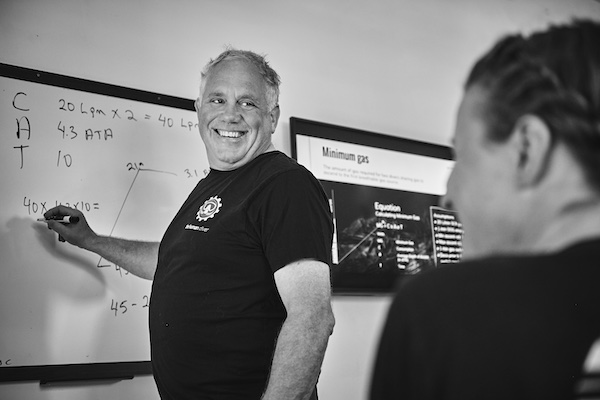
Summary
Leadership is not easy and not everyone is suited to it. It requires time, effort and most importantly, reflection. This is why many people revert to management, but you are not going to get the most from your students or your team if you approach influencing others in this manner. Leadership is about building personal relationships. Spend time before and during the class to understand what makes your student ‘tick’. Once the class is finished, continue those personal relationships because it is much easier to sell to a referral (or repeat student) than it is to sell cold.
Note: the original advert was probably never actually placed in the Times. https://www.smithsonianmag.com/smart-news/shackleton-probably-never-took-out-an-ad-seeking-men-for-a-hazardous-journey-5552379/

Gareth Lock is the owner of The Human Diver, a niche company focused on educating and developing divers, instructors and related teams to be high-performing. If you'd like to deepen your diving experience, consider taking the online introduction course which will change your attitude towards diving because safety is your perception, visit the website
Want to learn more about this article or have questions? Contact us.

